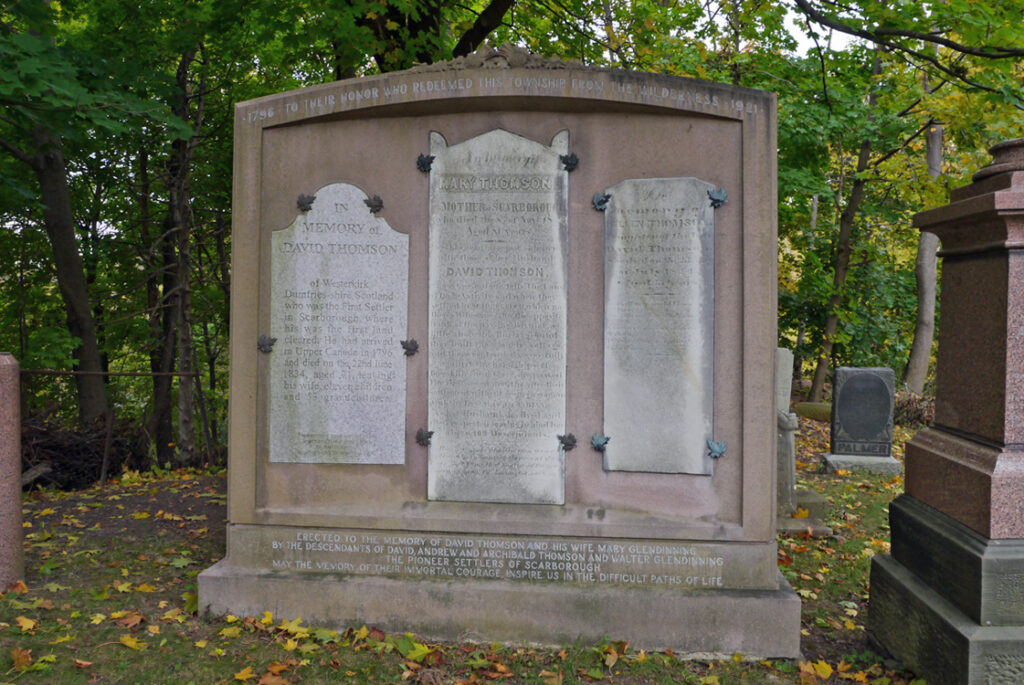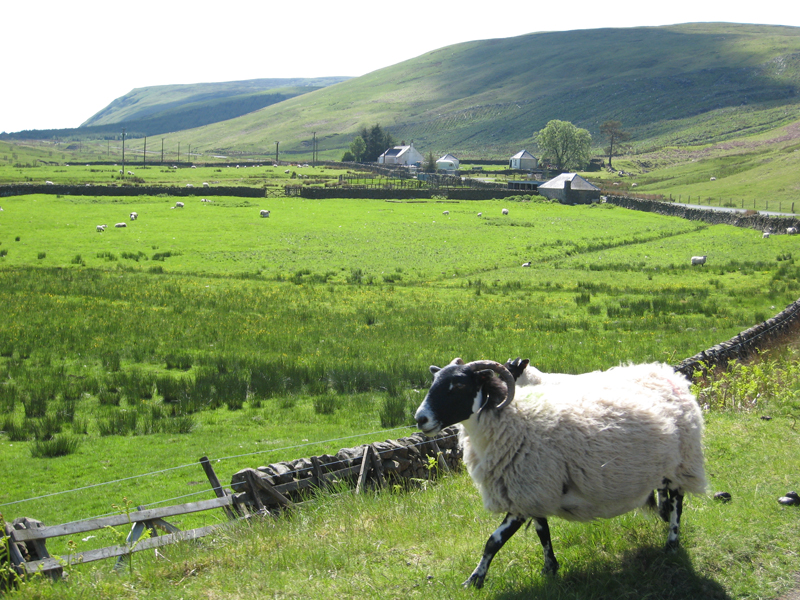Mary Glendinning (1768-1847), wife of David Thomson (1763-1834), was known as the Mother of Scarborough, Ontario.1 When the couple settled there in 1799, they were the first permanent European residents of the future Toronto suburb. David, a stone mason as well as a farmer, was often away working, leaving Mary at home to do the household chores and raise their 11 children.2
In addition to her role as mother to her own children and symbolic mother of this pioneer farming community, Mary was also aunt to my two-times great-grandfather, John Glendinning, and his siblings, and that family eventually followed Mary from Scotland to Scarborough.
Mary and David Thomson came to Upper Canada in 1796.3 At first they lived in Newark (now Niagara-on-the-Lake) with David’s brother Archibald. In 1797, they moved to York, as Toronto was then known, where David had a contract to build Governor Simcoe’s new government houses, while Mary took in sewing. But York was in a marshy area near Lake Ontario and Mary complained it was damp and unhealthy, so the family took the old trail used by the native people east from the town until they found a spot they liked near Highland Creek, Scarborough Township. There, they began clearing trees, built a log house and planted crops.

The Thomsons were originally from Westerkirk parish, Dumfriesshire, in the southwest of Scotland. They must have written enthusiastic letters to their relatives back home, telling them of the fertile farmland available in Upper Canada. For people like the Glendinnings, who had been tenant farmers and labourers for generations and had no hope of ever owning land in Scotland, immigration offered a unique chance to own property.
Very few immigrants were able to join the Thomsons until after the Napoleonic Wars (1799-1815) ended. This series of international conflicts made it very difficult for civilians to cross the Atlantic. When peace came, not only did travel become easier, but an economic depression in Great Britain pushed more people to take a chance on starting new lives abroad.4
Mary’s sisters Lilas and Jane and her brother John remained in Scotland, but her brother James Glendinning and his family settled in Streetsville, in Upper Canada, and brother William went to New Brunswick.5 Another brother, Walter Glendinning (b. 1770), and his wife, Elizabeth Park, probably immigrated to Scarborough, probably around 1820 .6 Their children – Mary’s nieces and nephews – unquestionably immigrated, since there are records of their births in Dumfriesshire and their marriages and deaths in Scarborough.
According to Ian Glendinning, compiler of the online Glendinning family tree (http://www.glendinning.name/index.html), Walter and Elizabeth Glendinning’s children were:
James, b. Westerkirk, 1796; m. Eliza Jane Wilkinson; d. Scarborough, 1861
Janet b. Westerkirk, 1798
Andrew, b. Westerkirk, 1800
William, b. Westerkirk, 1802; m. Elizabeth Borthwick, 1830; d. Scarborough, 1842
Archibald, b. Westerkirk, 1804; m. Jean Stobo, 1834; d. Scarborough, 1883
John, b. Westerkirk, 1807; m Margaret Whiteside, 1833; d. Scarborough, 1855
Walter, b. Westerkirk, 1809
Isabel, b. Westerkirk, 1814; d. Scarborough, 1832
Margaret, b. c. 1819, Scotland; m. Andrew Bertram; d. before 1861
When the Thomsons arrived in Scarborough in 1799, the government granted land to settlers for free, although people had to improve the land before they received title to it. Many of the people who received land in Scarborough’s early days were Loyalists, but few of them actually lived there or cleared the land for farming. Most of the early property owners rented out and eventually sold the land at a profit to later immigrants, like the Glendinnings. The Glendinnings would have rented until they could afford to purchase their farms.
A Toronto directory published in 18377 showed five Glendinning households in Scarborough: Walter on Concession I lot 28; Archibald and William both on Concession I lot 29 (the brothers shared the farm and Archibald had additional business interests, including the first store in the area); John on Concession V, lot 35; and James on Concession II, lot 23.
Ontario land title records8 confirm that members of the Glendinning family did eventually buy their farms. In 1829, William Glendinning and Archibald Glendinning purchased Concession I lots 29 and 30 from John Richardson. In 1850, John Glendinning bought lots 34 and 35 on Concession V from Thomas Street and, in 1861, Archibald Glendinning bought Concession I lot 28 from Kings College. Finally, they achieved their dreams of land ownership.
See Also:
Janice Hamilton, “The Glendinnings of Westerkirk”, Writinguptheancestors.blogspot.ca, Dec. 3, 2016, https://www.writinguptheancestors.ca/2016/12/the-glendinnings-of-westerkirk.html
Janice Hamilton, “Isabella Hamilton the North-West Rebellion,” Writinguptheancestors.blogspot.ca, Nov. 8, 2013, https://www.writinguptheancestors.ca/2013/11/isabella-hamilton-and-north-west_8.html
(Isabella (Glendenning) Hamilton, daughter of John Glendinning and Margaret Whiteside, was my great-grandmother.)
Notes and Sources
- There is a monument, erected in 1921, in St. Andrews Presbyterian Church Cemetery, Scarborough, “to the memory of Mary Thomson, the Mother of Scarborough, who died the 8th of Nov. 1847, aged 80 years.” The inscription recounts some of the hardships Mary experienced living in the wilderness, and it notes that, “as her husband, she lived and died respected, leaving behind her about 100 descendants.” The inscription across the bottom of the monument reads, “Erected to the memory of David Thomson and his wife Mary Glendinning by the descendants of David, Andrew and Archibald Thomson and Walter Glendinning, the pioneer settlers of Scarborough. May the memory of their immortal courage inspire us in the difficult paths of life.” I assume the Walter Glendinning mentioned in this inscription was Mary’s brother (and my three-times great-grandfather). Source: St. Andrews Presbyterian Church Cemetery (Bendale), Scarborough, Ontario. Transcribed by the Ontario Genealogical Society, Toronto Branch, 1988 and 1993.
- Robert R. Bonis, ed. A History of Scarborough, Scarborough: Scarborough Public Library, 1968; PDF, http://static.torontopubliclibrary.ca/da/pdfs/281086.pdf. This book includes a chapter on the early pioneers of Scarborough, including the Thomsons.
- David Thomson’s brother Archibald was the first member of the Thomson family to come to North America, settling in New York State in 1773. He remained loyal to the British during the American Revolution and moved to Canada after the war, eventually settling in Scarborough. David’s other brother, Andrew, also immigrated to Canada and lived on the farm next to David and Mary.
- Peter Aitchison and Andrew Cassell, The Lowland Clearances: Scotland’s Silent Revolution, 1760-1830, East Linton, Scotland: Tuckwell Press Ltd, 2003. This book describes the wave of emigration from the lowlands of Scotland because the landlords wanted to clear the tenant farmers off the land, enclose the fields with fences and raise cattle. This was not exactly the situation in Dumfriesshire, however, the book puts the family’s decision to leave their homeland into historical context.
- The home page of Ian Glendinning’s family tree is http://www.glendinning.name/index.html
Mary Glendinning, # 51, and her brother Walter, # 52, are fourth generation, http://www.glendinning.name/ancestry/glenfam/pafg04.htm; Walter’s children, who immigrated to Upper Canada and married there, are the fifth generation on this tree. - History of Toronto and the County of York Ontario, Volume II, Toronto: C. Blackett Robinson, publisher, 1885, p. 270. https://archive.org/details/historyoftoronto02mulvuoft This book states that Archibald Glendinning (Walter’s son, b. 1804) arrived in 1820, and other later publications repeat that date, but there is no evidence it is accurate and not just someone’s guess. I have not yet found death records for father Walter Glendinning or his wife Elizabeth, so I cannot confirm that they came to Upper Canada, but it is very likely they did so since their children were very young in 1820, when the family is said to have arrived. Also, Walter had a son Walter (b, 1809), so it is not clear whether the Walter Glendinning listed in an 1837 directory of the Toronto area was the father or the son.
- George Walton, The City of Toronto and the Home District Directory and Register with Almanack and Calendar for 1837, Toronto, U.C., printed by T. Dalton and W. J. Coates, p. 128; http://static.torontopubliclibrary.ca/da/pdfs/706129.pdf
- This information was provided by the Scarborough Historical Society archivist from microfilm of the Ontario land records.

